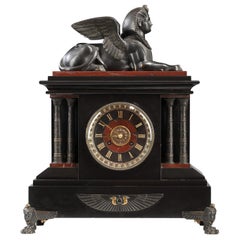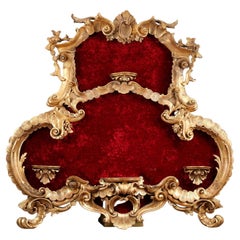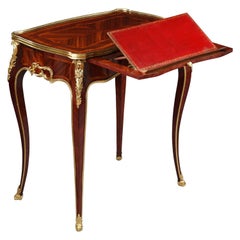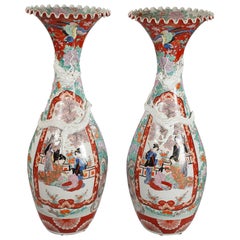Tobogan Antiques Furniture
to
69
273
273
33
18
7
4
3
3
2
1
1
5
226
42
20
10
8
13
3
3
3
1
2
3
194
171
91
78
45
266
238
15
8
7
273
273
273
11
4
4
3
3
Neo-Egyptian Bronze and Marble Clock Attributed to G.Servant, France, Circa 1870
By Georges Emile Henri Servant
Located in PARIS, FR
A black and red marble clock in the shape of an Egyptian temple attributed to G. Servant, flanked by double columns inscribed with hieroglyphs and ornated with a winged uraeus, all made in two patina bronze. The clock is surmounted by a patinated bronze sphinx. Resting on four bronze faces wearing the nemes and terminating in lion paw feet.
Georges Emile Henri Servant (circa 1828-1890) who took over his father in 1855 at their foundry, rue Vieille-du-Temple, in Paris, specialized in the production of neo-Egyptian style clocks, very popular in France since 1860s, and also the making of Greek style decorative objects. He drew considerable attention to the high quality of his bronzes at the 1855 Paris Universal Exhibition and then at the 1862 London Exhibition. At this time Servant exported up to 40% of his production, principally to the United States, where for instance, his sphinx clocks were sold with great success by Louis Tiffany Inc. or Hamann & Roche of New York (A similar clock is now exposed at the Metropolitan Museum of Art, New York). But his success came really at the 1867 Paris Universal Exhibition, where he was awarded a gold medal for his neo-Greek and Egyptian works (Les Merveilles...
Category
Antique 1870s French Egyptian Revival Mantel Clocks
Materials
Marble, Bronze
Pair of Covered Vases Attributed to Maison Lexcellent, France, Circa 1890
By E. Guillaume-Edmond Lexcellent
Located in PARIS, FR
Important pair of curved shape Louis XV style covered vases attributed to Maison Lexcellent, with godrons, in Aswan granite, gilded and chiseled bronze. The lid is topped by a pomegr...
Category
Antique 1890s French Louis XV Vases
Materials
Granite, Bronze
Giltwood Presentation Frame, Italy, Circa 1880
Located in PARIS, FR
Important presentation frame in carved and gilded wood, of curved shape, with symmetrical decoration of shells and foliage.
It is enriched with the two sides consoles...
Category
Antique 1880s Italian Shelves and Wall Cabinets
Materials
Velvet, Giltwood
Giltwood Thermometer & Perpetual Calendar Attributed to F.Linke, France, c. 1880
By François Linke
Located in PARIS, FR
Elegant Louis XVI style set comprising a thermometer and a perpetual calendar attributed to F. Linke. Each consisting of a metal plaque, painted with floral motifs on a beige backgro...
Category
Antique 1880s French Louis XVI Scientific Instruments
Materials
Sheet Metal
Louis XV Style Reading Table Attributed to H. Dasson, France, Circa 1885
By Henry Dasson
Located in PARIS, FR
Charming Louis XV style reading table attributed to H. Dasson. It opens on one side by a compartmental drawer and by a sliding shelf, forming a writing board and being able to switch...
Category
Antique 1880s French Louis XV Desks and Writing Tables
Materials
Bronze
$18,333 Sale Price
30% Off
Pair of Large Imari Porcelain Vases, Japan, Late 19th Century
By Imari Porcelain
Located in PARIS, FR
A very fine pair of Imari porcelain vases, of tapering form with flared top. Decorated with polychrome birds and flowers on white background. The body is painted with shaped panels o...
Category
Antique Late 19th Century Japanese Vases
Materials
Porcelain
Aesthetic Movement Gueridon, England, Circa 1860
Located in PARIS, FR
A Japanese style lacquered table consisting of a circular top adorned with a gold nuagé lacquered decor and with red exotic flowers and scrolled foliage. The top is supported by four...
Category
Antique 1860s English Aesthetic Movement Gueridon
Materials
Lacquer
Louis XVI Style Wall-Side Pedestal, France, Circa 1880
Located in PARIS, FR
A Louis XVI style wall-side veneered wood pedestal, mounted with fine gilt-bronze ornaments. Topped with “Brèche” marble.
Category
Antique 1880s French Louis XVI Pedestals and Columns
Materials
Marble, Bronze
Pair of "Alesia" Cups by F. Barbedienne and D. Attarge, France, Circa 1878
By Ferdinand Barbedienne, Désiré Attarge
Located in PARIS, FR
Signed Désiré Attarge Fit and F. Barbedienne Paris
Pair of silvered bronze cups, chased by Désiré Attarge after an antique model (Ist Century), known as the Coupe d’Alésia or Cantha...
Category
Antique 1870s French Decorative Bowls
Materials
Bronze
$4,571 Sale Price / set
43% Off
Elegant Pair of Flowery Valentine Porcelain Vases, France, Circa 1860
Located in PARIS, FR
Charming pair of baluster shaped vases made in Valentine porcelain, with openwork handles enhanced with gold. They are decorated on the front with ...
Category
Antique 1860s French Napoleon III Vases
Materials
Porcelain
$8,380 Sale Price / set
20% Off
Renaissance Style Center Table by Cortina D'Ampezzo, Italy, Circa 1890
Located in PARIS, FR
Label mentioning “I.R. Scuola, Sezione Intarsio e Intaglio, Cortina d’Ampezzo, n°146”
Exceptional Venetian Renaissance style center table. The top and the frieze opening with four...
Category
Antique 1890s Italian Renaissance Center Tables
Materials
Wood
$13,809 Sale Price
51% Off
Rare Center Table Attributed to A.E. Beurdeley, France, Circa 1880
By Alfred Emmanuel Louis Beurdeley
Located in PARIS, FR
Center table made exclusively in richly carved wood and attributed to A.E. Beurdeley ; with a fine pierced belt ornamented with laurel branches. Raised on four legs joined by a stret...
Category
Antique 1880s French Tables
Materials
Griotte Marble
$13,809 Sale Price
37% Off
Neo-Greek Gueridon Attributed to F. Barbedienne, France, Circa 1880
By Louis-Constant Sevin, Ferdinand Barbedienne
Located in PARIS, FR
A similar model was exposed at the 1889 Paris Universal Exhibition ( see picture attached)
Patinated and gilded bronze gueridon with four paw feet joined by X-shaped stems, attributed to Sévin and Barbedienne. Round green marble top mounted with a bronze rim adorned with oves and pearls motif.
Born in 1821 and dead in Paris in 1888, Louis-Constant Sévin was apprenticed to the parisian sculptor Marneuf. In 1839, he joined the sculptor-modelors Phénix and Joyau, as designer, and designed silver-smith’s objects for famous firms like Denière, Froment-Meurice, Morel and Duponchel. During the Revolution in 1848, C. Sévin joined Morel in London, as workshop manager and designed pieces that Morel exhibited in 1851. Back in France in 1851, C. Sévin went to Limoges and designed models for the porcelain factories of Jouhanneaud and Dubois of which many pieces were exhibited at the Universal Exhibition in 1855. From this date on, he worked for Ferdinand Barbedienne as sculptor-ornemanist until the end of his life. Sévin’s works are considerable, he designed furniture bronzes for the « hôtel de La Païva ». At the London Exhibition in 1862, he was awarded a medal « pour l’excellence artistique des meubles qu’il a dessinés et qui sont exposés par Barbedienne » : for the artistic excellence of the furniture he designed and which is exhibited by F. Barbedienne. He won a second class medal at the Union centrale des Arts décoratifs Exhibition in 1863 and was awarded a gold medal as « cooperator ». F. Barbedienne said that posterity would remember Sévin’s compositions. The most extraordinary object designed by C. Sévin for F. Barbedienne, was a Renaissance style gilded bronze monumental clock...
Category
Antique 1880s French Greek Revival Center Tables
Materials
Marble, Bronze
Pair of Neo-Greek Wall-Lights Attributed to F. Barbedienne, France, Circa 1880
By Ferdinand Barbedienne
Located in PARIS, FR
A pair of neo-Greek wall-light sconces executed in two patina bronze attributed to F. Barbedienne. The central up-turned foliage stem, surmounted by a Greek style vase...
Category
Antique 1880s French Greek Revival Wall Lights and Sconces
Materials
Bronze
$13,809 Sale Price / set
29% Off
Combined Techniques Painting "The Three Sisters" by C. Josuan, Argentina, 1896
Located in PARIS, FR
Inscribed Cecilia Josuan, Colegio de N. S. del Huerto, Buenos Aires, 1896
A rare “fixé sous verre” painting using a combined technique of chromolithography for the faces and hands, and silk embroidery for the clothes and background drape. Representing three women holding each other’s hands.
Chromolithography technique uses thin paper motifs glued and varnished to integrate its support.
Along from the rich Spanish legacy, Argentina is also very influenced since 19th century by European culture, notably Italian. Traces of American Indian culture are harder to find than in the other Latin America countries. During 19th century, with the National pride appears Argentina specific cultural themes. The Gaucho character, keeping the cattle in the Pampas, is recurrent in literature and particularly in poetry: Fausto (1866), by Estanilaslao del Campo, or Martin Fierro (1872), by José Hernandez, often considered to be an hymn to the Pampa. Painting also celebrates this genre with the works of painter Prilidiano Pueyrredon (1823-1870).
At the beginning of 19th century, painters in Latin America and particularly in Argentina are foreigners (French, Germans and British) named Costumbristas, painting folkloric landscapes and portraits much appreciated in Europe. During second part of 19th century, a national painting appears with internationally renowned painters such as Prilidiano Pueyrredon, Angel de La Valle...
Category
Antique 1890s Argentine Paintings
Materials
Glass, Paint, Paper, Silk
$9,047 Sale Price
58% Off
Fine Pair of 'Cloisonne' Enamel Dishes Attributed to A. Giroux, France, c. 1880
By Alphonse Giroux et Cie
Located in PARIS, FR
Beautiful pair of polychrome “cloisonné” enamel display dishes attributed to A. Giroux, decorated with birds flying over rushes and flowers on a sky blue background, bordered with a stylized foliate motif frieze. Finely mounted with gilded bronze ornaments such bamboos, masks and scrolls.
Alphonse Giroux and company, famous curiosity and luxury goods shop was situated at No. 7 rue du Coq-Saint-Honoré and in business from the time of the Consulate until the end of the Second Empire. The company was founded by Francois-Simon-Alphonse and continued in 1838 by his two sons, Alphonse-Gustave (1810-1886) and André (1801-1879).
The father became a close associate of the royal family and specialized in the manufacture of refined items for gifts, winning a silver medal at the in 1834. Kings Louis XVIII and then Charles X were both supplied with gifts for “The Children of France” by Giroux. Making progressively small furniture, they were mentionned for the first time in 1837 in the class “cabinet...
Category
Antique 1880s French Decorative Dishes and Vide-Poche
Materials
Enamel, Bronze
$11,428 Sale Price / set
20% Off
Fine Orientalist Dish by Lebeuf, Milliet & Cie, France, Circa 1845
By Lebeuf Milliet & Cie Creil Montereau
Located in PARIS, FR
Signed by Cojoie AD, the decor-painter
and on the reverse, LM et Cie, the making mark of the manufacture
A circular hand painted pottery charger, decorated with an orientalist sc...
Category
Antique 1840s French Decorative Dishes and Vide-Poche
Materials
Earthenware
$8,095 Sale Price
45% Off
Chinese Porcelain Mural Fountain Attributed to L'Escalier de Cristal, c. 1880
By L'Escalier de Cristal
Located in PARIS, FR
18th century Famille verte China porcelain mural fountain, decorated with lotus, tree and bird motifs. The faucet is coming out of a dragon mouth. Beaut...
Category
Antique 1880s French Chinoiserie Porcelain
Materials
Bronze
$11,220 Sale Price
24% Off
Charming Japanese Style Tray Attributed to l'Escalier de Cristal, France, c.1880
By L'Escalier de Cristal
Located in PARIS, FR
Rare Japanese style diamond-shaped tray attributed to l'Escalier de Cristal, representing lake landscapes in cartouches, and adorned in its center with a lunch scene with a Japanese couple in traditional dress, all highlighted by a gilded decor of flowering branches on a pink porcelain background.
The whole is framed by a gilded openwork bronze mount ending on the sides by two handles.
“L’Escalier de Cristal”, an old and famous Parisian firm, specialized in glass products and ceramics but also suggested furniture and bronze sculptures. It was led from 1885 to 1923 by Emile Pannier’s sons, who gave the name of Pannier Frères to the society, located at the corner of Scribe street and Auber street, next to the new built Paris Opera house. Their Japanese style creations were among many others much appreciated by the critics and the public. They were awarded many medals at various exhibitions, such as the Gold medal at the 1900 Paris Universal Exhibition.
Lots of artists participated in that world success, such as Emile Gallé, who gave to Pannier Frères the exclusive rights of some of his models, or François-Eugène Rousseau, who designed many vases and gave the model of his successful Japanese style dining-set as well. This set was made by the Creil et Montereau Manufacture. In the Japanese style furniture...
Category
Antique 1880s French Japonisme Decorative Dishes and Vide-Poche
Materials
Bronze
Pair of Aesthetic Movement Vases Attributed to Susse Frères, France, Circa 1880
By Susse Freres
Located in PARIS, FR
A very fine pair of Japanese style vases attributed to Susse Frères and made in two patina bronze. Each vase in form of a patinated bronze ovoid body...
Category
Antique 1880s French Japonisme Vases
Materials
Bronze
$1,523 Sale Price / set
20% Off
Rare Aesthetic Movement Wall-Light Attributed to G. Viardot, France, Circa 1880
By Gabriel Viardot
Located in PARIS, FR
A large Japanese style four lights sconce attributed to G. Viardot, in shape of a dragon made in carved tinted wood, holding in its mouth a Japanese blossoming cherry tree branch, fr...
Category
Antique 1880s French Japonisme Wall Lights and Sconces
Materials
Wood
$20,952 Sale Price / item
21% Off
Elegant Set of Three Gilded Bronze Mirrors, Italy, 19th Century
Located in PARIS, FR
Main mirror: Height : 49 cm (19.3 in.) ; width : 43 cm (16.9 in.) ; depth : 6 cm (2.3 in.)
Small mirrors: Height : 40 cm (15.7 in.) ; width : 34 cm (13.4 in.) ; depth : 4 cm (1.6 in....
Category
Antique 19th Century Italian Table Mirrors
Materials
Bronze
$16,071 Sale Price / set
27% Off
Pair of Louis XVI Style Covered Vases Attributed to Samson & Cie, France, c.1890
By Samson & Cie
Located in PARIS, FR
Pair of Louis XVI style baluster shaped covered vases attributed to Samson & Cie, made in porcelain with green background and gold dots, flanked by two applied handles made of white ...
Category
Antique 1890s French Louis XVI Vases
Materials
Bronze
$7,619 Sale Price / set
46% Off
Rare Neo-Pompeian Salon Suite Attributed to J-P Mazaroz, France, Circa 1860
Located in PARIS, FR
Neo-Pompeian salon attributed to Paul Mazaroz, composed of two armchairs, two chairs and a wooden mirror embellished with a gilded decor on a black lacquered background. A patinated ...
Category
Antique 1860s French Living Room Sets
Materials
Bronze
$14,315 Sale Price / set
35% Off
Elegant Pair of Japanese Style Dishes, France, Circa 1875
Located in PARIS, FR
Pair of 18th century soft-paste porcelain dishes finely decorated in the 19th century with medallions representing Japanese theatre characters dressed in traditional costumes, beautiful gold-embossed ornament on a polychrome background.
These dishes are to be linked with the production of the Sèvres Manufacture.
The Manufacture de Sèvres, factory of soft-paste porcelain, was founded in 1738 at Vincennes by bankers and financiers hoping to discover the secret of making hard-paste porcelain, used in Meissen at the time. In 1753, King of France Louis XV became the main shareholder of the factory, transferring it to Sèvres, closer to Versailles and the castle of Bellevue, owned by la Marquise de Pompadour, very interested by Sèvres’ research and supportive of the works. In 1759, the King became the sole shareholder of the Manufacture, making it the property of the French Crown. From this day on, the Sèvres artworks were marked with the royal seal, two intertwined “L’s”, as well as a letter indicating the year of creation. The period between 1756 and 1779 represents the most prosperous years for the factory. To support Sèvres, Louis XV made sumptuous orders offered as diplomatic presents. The main artists at the time, such as painters Boucher and Bachelier or sculptors Falconet and Boizot, worked for the factory. Research on the making of hard-paste porcelain kept going and succeeded after 1769. From this year, Sèvres successfully produced both soft-paste and hard-paste porcelain. It is also during this period that the most beautiful and singular colors were invented: bleu lapis in 1752, bleu celeste in 1753, green in 1756, famous pink in 1757 and royal blue in 1763. The most significant pieces are ornamented with scenes inspired by engravings from famous painters (Boucher) and ornamentalists. They are also decorated with garlands, bunches of flowers, trophies, gildings… The fine quality of Sèvres’ production covers a large range of statuettes (Falconet’s threatening Love), full services (Rambouillet’s service is presented to Marie-Antoinette in 1788), as well as utilitarian or ornamental items. The role played by haberdashers in the production’s development is essential. They originated trends around Sèvres-designed products, such as Daguerre who decorated his most precious furniture with porcelain...
Category
Antique 1870s French Porcelain
Materials
Porcelain
$5,238 Sale Price / set
63% Off
Pair of Neo-Greek Vase-Candlesticks Attr. to Barbedienne and Levillain, c. 1880
By Ferdinand Levillain, Ferdinand Barbedienne
Located in PARIS, FR
Pair of Greek style amphora shaped candlesticks made of gilded and patinated bronze attributed to F. Levillain and F. Barbedienne. Each flanked with two handles, and decorated with horsemen in relief. Standing on three lion’s feet headed with busts of putti and raised on a red griotte marble base.
Ferdinand Levillain (Paris, 1837-1905) studied under the sculptor Jouffroy (1806-1882), before making his debut in 1861 at the French Artists Salon where he continued to exhibit until 1903. At the 1867 Universal Exhibition in Paris, he was praised for a Neo-Greek style bronze cup he made for the firm Blot and Drouard. He was not to become really famous, however, until 1871 thanks to his association with the great bronze founder Ferdinand Barbedienne, who began to exhibit Neo-Greek style lamps...
Category
Antique 1880s French Greek Revival Table Lamps
Materials
Bronze
$4,333 Sale Price / set
57% Off
Lovely Crystal and Silvered Bronze Jardiniere by Cardeilhac, France, Circa 1860
By Cardeilhac
Located in PARIS, FR
Signed Cardeilhac, Paris.
A jardinière consisting of an oval bowl in engraved crystal, decorated with a frieze of foliate waves and a rayed star in the bottom. It fits into a silv...
Category
Antique 1860s French Planters, Cachepots and Jardinières
Materials
Crystal, Bronze
$1,999 Sale Price
52% Off
Rare Wood, Patinated Iron and Gilded Bronze Dedicated Column, 1896
Located in PARIS, FR
A rare wood column adorned with patinated iron and gilt bronze ornaments. It relies on four bronze feet and is topped with a foliate bronze capital with caduceus. A bronze band is ci...
Category
Antique 1890s Pedestals and Columns
Materials
Bronze, Iron
$6,071 Sale Price
25% Off
Lovely Neo-Greek Planter Attributed to C-G Diehl, France, Circa 1870
By Charles-Guillaume Diehl
Located in PARIS, FR
Circular plant pot with a double tray united by a black tripod attributed to C-G Diehl. Charming wood marquetry. A beautiful gilded bronze adornment complete this piece.
Arriving in...
Category
Antique 1870s French Greek Revival Planters and Jardinieres
Materials
Bronze
$9,642 Sale Price
40% Off
"Florentine Singer" Bronze Sculpture by P. Dubois and F. Barbedienne, Circa 1880
By Paul Dubois, Ferdinand Barbedienne
Located in PARIS, FR
Signed P. Dubois 1865 and F. Barbedienne fondeur
Stamped with réduction mécanique Collas
A patinated bronze « Florentine Singer » sculpture, inspir...
Category
Antique 1880s French Figurative Sculptures
Materials
Bronze
Pair of Louis XVI Style "Sèvres" Porcelain Candelabra Vases, France, Circa 1880
By Manufacture Nationale de Sèvres
Located in PARIS, FR
A Louis XVI style turquoise porcelain vases with a polychrome decoration in the style of the Manufacture of Sèvres. Each side is adorned with...
Category
Antique 1880s French Louis XVI More Lighting
Materials
Bronze
$7,333 Sale Price / set
41% Off
Fine Neo-Greek Clock Set by H. Houdebine, France, Circa 1867
By Henri Houdebine
Located in PARIS, FR
Dial signed H. Houdebine, Fabricant de Bronzes, Rue de Turenne 64, Paris
and clockwork signed Japy Frères & Cie – Médaille d’Honneur
A very fine neo-Greek style clock set made up of...
Category
Antique 1860s French Greek Revival Table Clocks and Desk Clocks
Materials
Bronze
$10,476 Sale Price / set
29% Off
Louis XVI Style Barometers and Thermometers by H. Dasson, France, Circa 1880
By Henry Dasson
Located in PARIS, FR
A companion pair of Louis XVI style barometer and thermometer finely decorated with gilt bronze acanthus leaves and seeds on green velvet, each with a polychrome decorated enamel pla...
Category
Antique 1880s French Louis XVI Scientific Instruments
Materials
Enamel, Bronze
$8,333 Sale Price / set
43% Off





